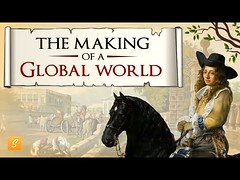The Making of a Global World
Introduction
The world as we know it today—interconnected and interdependent—is the result of centuries of global interaction. Trade routes, migrations, colonization, wars, and revolutions have all played a significant role in shaping the “global world.” In this chapter, we explore how this global world was created, starting from pre-modern trade to the impact of industrialization and modern globalization.
I. The Pre-Modern World
Even before the 16th century, civilizations were not isolated. On the contrary, people, goods, and ideas moved across continents, connecting societies and cultures through trade and exchange.
🔹 Silk Routes: The Ancient Global Connectors
Silk Routes were ancient networks that linked Asia, Europe, and Africa. These trade paths allowed for the exchange of luxury items such as silk, spices, porcelain, and precious metals.
Moreover, they were not just economic pathways—they facilitated cultural and religious exchange as well. For instance, as a result, Buddhism spread from India to China and beyond.
Did You Know?
The term “Silk Route” comes from the high demand for Chinese silk in Europe.
🔹 Food Travels: A Global Culinary Exchange
Simultaneously, global interaction was visible in the movement of food crops. During the Columbian Exchange (named after Christopher Columbus), new crops like potatoes, maize, and chillies were introduced to Europe and Asia from the Americas.
Consequently, these became staples and transformed diets across the world.
II. The Nineteenth Century (1815–1914): A Global Economy Takes Shape
The 19th century saw the rise of industrial capitalism, the expansion of empires, and greater economic integration. During this period, technological advancements and colonial policies drastically changed global economies.
🔹 A World Economy Emerges
To begin with, industrial production surged in Britain, turning it into the “workshop of the world.” Machine-made goods were exported worldwide, especially to colonies like India.
Meanwhile, these colonies provided essential raw materials and became major markets for British products.
🔹 Impact on Lives: Rural India and Britain
In India, farmers were forced to cultivate commercial crops such as indigo and cotton.
As a result, local industries declined due to competition from cheaper, mass-produced British imports.
In contrast, in Britain, industrial growth created jobs in urban areas. However, this came at the cost of poor working conditions, especially for women and children.
Eventually, the Corn Laws were abolished, leading to cheaper food prices and benefits for industrial workers.
🔹 Migration and Labor Movement
Simultaneously, the global economy required a large labor force. Millions migrated for work—some voluntarily, others under coercion.
Indentured laborers from India were transported to places like the Caribbean, Fiji, and Mauritius.
Despite promises, the contracts were harsh and exploitative, often resembling slavery.
III. The Inter-War Economy (1914–1945)
The early 20th century was turbulent, marked by two world wars and a severe economic depression. Together, these events reshaped global political and economic structures.
🔹 The First World War (1914–1918)
The war led to massive human and material loss.
In order to fund military operations, governments borrowed heavily and raised taxes.
Afterward, Europe’s economic dominance declined, and the United States rose as a powerful industrial nation.
🔹 The Great Depression (1929–1933)
Following the war, the world experienced the Great Depression, triggered by the Wall Street Crash.
It resulted in high unemployment, falling incomes, and global economic instability.
In colonies like India, agricultural prices crashed, but farmers found no buyers for their produce.
🔹 The Second World War (1939–1945)
Soon after, the Second World War broke out, causing even greater destruction.
Eventually, this led to a new world order.
To prevent future conflicts and stabilize economies, countries began to think about global economic institutions.
IV. Rebuilding a Global World (Post-1945 Era)
Following WWII, nations took active steps to rebuild economies and create lasting peace.
🔹 Bretton Woods Conference (1944)
Held in the United States, this conference saw 44 countries agree on a new international monetary system.
As a result, two key institutions were formed:
- IMF (International Monetary Fund) – to ensure currency stability.
- World Bank – to fund reconstruction and development projects.
🔹 Controlled Economies
In the years that followed, many Western nations adopted economic planning.
Instead of pure capitalism, governments played a key role in managing economies.
Similarly, newly independent countries like India adopted mixed economies—combining state intervention with private enterprise.
V. Globalization and the Late 20th Century
The 1970s and 1980s marked a new phase of globalization, driven by liberalization and technology.
🔹 End of Bretton Woods System (1970s)
Gradually, the Bretton Woods system collapsed.
The US dollar was delinked from gold, and fixed exchange rates gave way to flexible ones.
Consequently, financial markets became more volatile but also more integrated.
🔹 Rise of MNCs (Multinational Corporations)
Meanwhile, multinational companies began to dominate global trade.
They outsourced manufacturing and services to countries with cheaper labor, especially in Asia.
Thus, developing nations became central to global production networks.
🔹 India’s Liberalization (1991)
By the early 1990s, India faced a severe financial crisis.
Therefore, the government introduced liberalization policies to open up the economy.
These included:
- Privatization of public sector enterprises
- Deregulation of industries
- Encouragement of Foreign Direct Investment (FDI)
As a result, India became a key player in the global economy.
Conclusion: Making Sense of the Global World
From ancient trade routes to modern multinational corporations, the making of a global world is a story of both integration and inequality.
While globalization brought prosperity to many, it also widened the gap between rich and poor, developed and developing nations.
In summary, the global world has evolved through trade, conquest, migration, colonization, industrialization, and economic reforms.
Therefore, understanding this historical journey helps us better comprehend the challenges and opportunities of our interconnected world.

